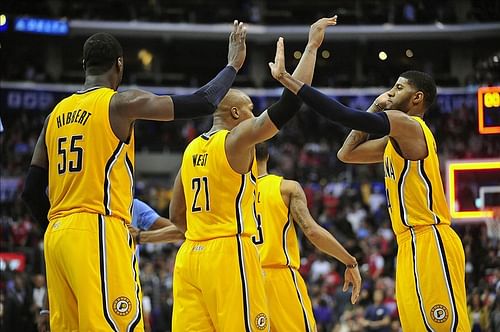
The defence rests: The Indiana Pacers get it right, again

The Indiana Pacers
The NBA, through all of its formative years, has always been a league of trends. Trends in the NBA come and go out of fashion, and this is not only with respect to the questionable wardrobe choices that some star players sport; it is also applicable to the way the game is played. Some trends stick, some don’t and some are twisted and evolved so that they do not resemble anything like what they were when first introduced.
Backpedal a bit and reflect on that statement. There have been so many changes in how the game is played that it is hard to keep track of it all. Remember the Celtics? Not the current washed-up, lottery-bound version, but the one which terrorized the NBA in the 60s. Bill Russell was the marquee player in that Celtics dynasty, bullying the league for a good decade. They won with tenacious rebounding and defence.
Fast forward to the 2008 champion version of the Celtics and you will notice the same thing. This time Russell was replaced by Kevin Garnett, a player maybe of lesser stature but equal tenacity. The 2008 Celtics team was a brilliant defensive unit, making life miserable for opposition teams.
If we squint our eyes and think hard, we would be able to come up with almost a dozen trends that have changed the execution and play of the game. One such trend-setter that jumps up almost immediately for any moderate NBA fan with a little knowledge of the history of the game is the 2004-2007 Phoenix Suns team. That’s right, the ‘SEVEN SECONDS OR LESS’ Phoenix Suns, arguably one of the most entertaining and critically acclaimed teams in the NBA. Most of the fast-paced offences we see in the present league are trying to modify or perfect the formula the Phoenix Suns used.
That Phoenix team was an offensive juggernaut which lay waste to the most fundamental rule of basketball which states, “You need defence to win a ball game”. Purists frowned at the concept, saying that it was not the correct way to play, but fans rejoiced because the games were so wildly entertaining – replete with fast-breaks, no-look passes and three point bombs from almost every spot behind the line. Of course, when you have a certain point guard by the name of Steve Nash marshalling your troops, entertainment is just a by-product of the sheer amount of creativity on the court.
The bottomline is that the Suns just outran everybody. They believed that more possessions mean more attempts at the basket, resulting in more opportunities to score. What good was defence and why waste energy on it, when you could simply outscore opponents on a nightly basis?
Since the ‘seven seconds or less’ Suns, the pace of the game has seen massive improvement. Gone are the days when a ball game was a slug-fest of missed shots, defensive rebounds and post-up plays. Few teams care about the nuances of team defence any more, with analytics playing a major role in team decisions and shot attempts. All of that, coupled with the dramatic increase in the importance of the 3-point shot, has made even well-oiled offences like those of the Blazers and the Rockets pay little heed to the defensive end.
Amid all the points and the dunks, one team’s defence has been almost as loud as or maybe louder than all the offences combined. The Indiana Pacers have transformed into the kind of defensive force that makes opposition teams actually wonder if there is an efficient way of scoring against them. Indy ranks first in points allowed per game at 93.6. This means that no other team in the NBA allows fewer points per game than the Pacers. Frank Vogel is a defensive genius along the lines of Tom Thibodueau, and his suffocating defensive schemes are as much a part of Indiana’s defence as are the individual talents of its starting players.